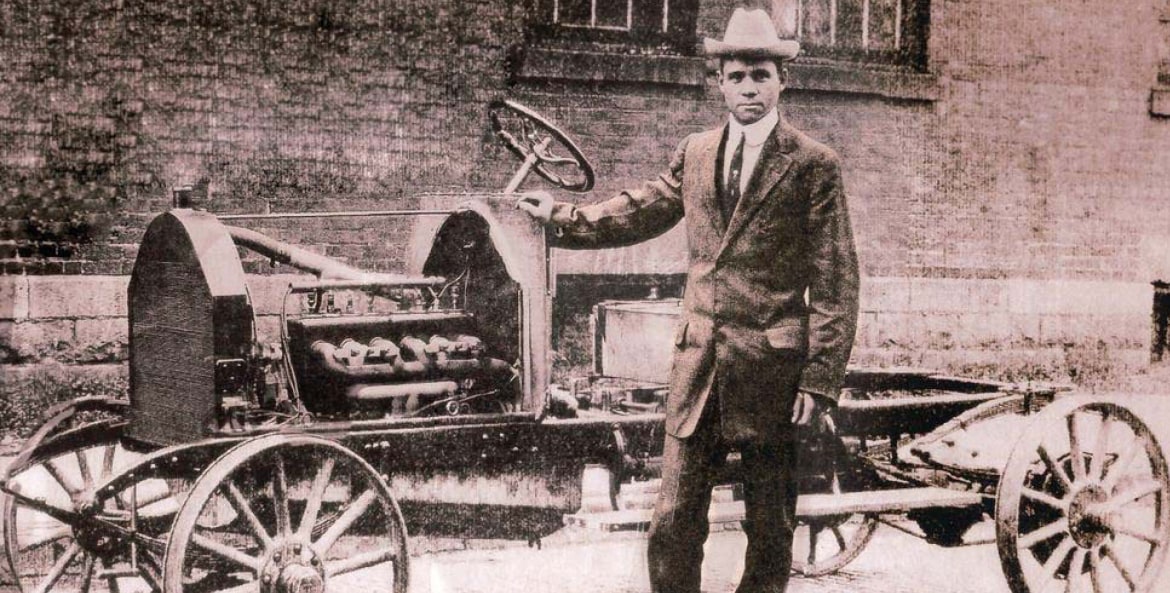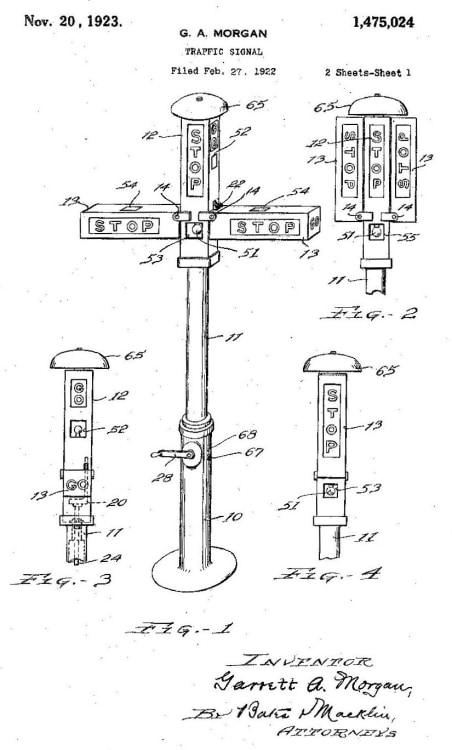Black Pioneers in Automotive History
As inventors, entrepreneurs, and racers, these African Americans broke barriers in the car world.

Like nearly every other aspect of America’s past, countless names have been lost or forgotten through the years of the automotive industry’s history. All too often, those names belonged to people of color. Black pioneers have made innumerable contributions to the car world. Here are eight trailblazers who steered the industry—and society as a whole—in the right direction.
Cliff Hall: Designed the Innovative Corwin Getaway Sports Car
Born in Los Angeles in 1925, Hall was always creative and multi-talented. As a kid, he and his Japanese-American best friend, Wallace Arima, designed cars that they entered into soapbox derbies.
After returning home from World War II, Hall ran his own photography studio, specializing in society photos for wealthy clients and the Los Angeles Sentinel newspaper. But he had a bigger dream: Design a stylish automobile that could easily maneuver through city traffic. Hall wanted it to be manufactured in the community and provide employment for African American and Latino workers.
He launched his ambitious project in the aftermath of the 1965 Watts riots. Thanks to his work as a photographer, he was able to attract investors including boxing champ Muhammad Ali, actor Sidney Poitier, and Louis Corwin, a Beverly Hills businessman and Hall’s largest supporter. He was able to create a prototype of the Corwin Getaway by 1969, but couldn't attract enough funding to go into mass production.
Hall passed away in January 2020, but the prototype Corwin Getaway is preserved in the permanent collection of the Petersen Automotive Museum in Los Angeles.
Leonard Miller: First African American Team Owner to Win a Race in NASCAR
Growing up outside of Philadelphia in the 1930s, Leonard Miller was introduced to automobiles at a young age through his mother, who worked as a housekeeper. “All of these rich, white families had all these rare cars that were beautiful and sounded good,” Miller told Smithsonian Magazine. “So, I said that was for me. And that’s what started me off to a lifetime of races.”
He would go on to pave the way for African Americans in the world of auto racing. It began when he formed Miller Brothers Racing, which won dozens of races throughout the Northeast from 1969 to 1971.
In 1972, he became the first African American owner to enter a car in the Indianapolis 500. Miller’s team was also the first Black professional race team to have a national sponsorship and to enter a Black driver in competition in England.
During this time, Miller also created the Black American Racers Association with, among others, Wendell Scott. The group promoted driver development and honored African Americans in auto racing. At its height, it included 5,000 members from 20 states and several racing disciplines.
With the help of his son, the automotive pioneer later founded NASCAR’s Miller Racing Group.
The team won many races through the 1990s and early aughts. In fact, the father-son duo became the first African American team owners to win a track championship in NASCAR history with a victory at Virginia’s Old Dominion Speedway in 2005.
Miller was inducted into the Black Athletes Hall of Fame in 1973. Many of his awards, trophies and other memorabilia are currently housed at the Smithsonian Institute.

The patent drawing for Garrett Morgan's traffic signal.
Garrett Morgan: Invented Three-position Traffic Signal
Born in Kentucky in 1877, Garrett Morgan would go on to become one of the great inventors of his time. By the 1920s he already had several inventions under his belt, including hair refiner and an early version of the gas mask.
Morgan’s success allowed him to own an automobile (reportedly the first African American in Cleveland to do so). After witnessing a terrible accident at an intersection, an idea was sparked.
Traffic signals had already been invented but they only consisted of two signals: Go and Stop. The problem was that drivers never knew when the signal was going to switch. This caused cars to stop abruptly or still be in the intersection when vehicles traveling in other directions began to move.
To solve this, Morgan invented a T-shaped traffic signal that had a third Caution signal—essentially, a yellow light. When the Caution signal was on, traffic in all directions stopped and intersections would clear. In 1923, Morgan was awarded a patent for a three-position traffic signal. His original traffic signal prototype is on display at the Smithsonian’s Museum of American History.
Aside from his technical contributions to society, Morgan was also a pillar in Cleveland’s African American community. He founded the Cleveland Call, one of the most important African American newspapers in the country, and was a leader in the city’s NAACP chapter.
C.R. Patterson: Founded Forerunner of First Black-owned Car Company
C.R. Patterson was born enslaved in Virginia in 1833 but later escaped to settle in Ohio. He learned blacksmithing and worked for a carriage maker before co-founding his own business in 1873. For the next 20 years, the company ran a successful business making expertly crafted horse-drawn carriages.
In 1893, Patterson bought out his partner and formed C.R. Patterson & Sons. When he died in 1910, his son Fredrick took over the flourishing business as the transportation business was revolutionizing. The younger Patterson began noticing an influx of “horseless carriages” on the roads and knew that automobiles were the future. C.R. Patterson & Sons produced its first car in 1915. The Patterson-Greenfield automobile—which historians say was comparable in quality and workmanship to the Ford Model T—sold for $850.
Patterson & Sons quickly established itself as legitimate auto manufacturer. According to the National Museum of African American History & Culture, it remains the only African American-owned automobile company in United States history. There are no known Patterson-Greenfields left in existence today, but several C.R. Patterson & Sons Company carriages have survived.
Homer B. Roberts: The First Black Car Dealer
Homer B. Roberts was the first African American car dealer in the country but his greatest achievement occurred far away from the dealership. A veteran of World War I, Roberts was the first Black man to attain the rank of lieutenant in the United States Army Signal Corps.
Following the war, Roberts moved back to his native Kansas City and began selling cars. He specifically targeted selling to the African American community. In 1919, he put his first ad, for seven used cars, in the “Kansas City Star,” the prominent local Black newspaper. By the end of the year, he had secured 60 sales—all to Black drivers.
In the following years, business continued to grow. Roberts opened offices and showrooms and hired salesmen. In 1923, he opened a brand-new dealership named Roberts Company Motor Mart. Smaller automobile manufacturers saw potential in the African American market and backed his business. This helped Roberts land franchises with Hupmobile, Rickenbacker and Oldsmobile.
Hit hard by the Depression, the dealership closed in 1929—but not before Roberts had etched his name in history.

Wendell Scott began his racing career driving homebuilt "modifieds" such as this one.
Wendell Scott: Broke NASCAR’s Color Barrier
Wendell Oliver Scott was born in Danville, VA, in 1921. He learned about cars from his auto-mechanic father. His first job was driving a taxi before he started running moonshine whiskey, which required him to drive fast in order to evade the police.
At the time, Danville’s racing scene was struggling with attendance. Owners thought recruiting an African American driver would help fill seats. They asked the local police for the fastest driver in town and in 1952, Scott became the first African American to compete in an official stock car race. He would go on to win 120 races in lower divisions, while continually being denied entry into NASCAR because of his race.
Then, in 1961, Scott was able to take over the auto-racing license of white NASCAR driver Mike Poston. He was officially a member of NASCAR’s top-level Grand National circuit—the first African American to do so. Just two years later, Scott became the first Black driver to win a NASCAR premier series event with a victory at the 100-mile race at Speedway Park in Jacksonville, FL.
By the end of career in 1973, Scott had accumulated 20 top-five finishes. The NASCAR Hall of Fame, into which Scott was inducted in 2015, lists his 495 starts 32nd on the all-time list.
Scott passed away in 1990. It would be another 23 years before a second African American, Bubba Wallace, won a NASCAR race, a full half-century after Scott accomplished the feat.
Richard Spikes: Inveterate Inventor
Little is known of Richard Spikes’s personal life. Conflicting accounts place Spikes’s origins—born somewhere in the West in 1878—in Texas, Oklahoma, or San Francisco. What is known is that, as a young man, he moved with his wife and son to California, eventually establishing a home in Los Angeles.
Spikes was interested in improving the operations of machines that influenced the everyday lives of people, and his inventions were recognized and purchased by major companies. Milwaukee Brewing Company purchased his 1910 design for a beer keg tap, still in use today. Pierce Arrow bought his directional signals apparatus, which became standard in all cars in 1913. The San Francisco Key Line—the Bay Area’s early consolidated electric railway system—implemented his continuous-contact trolley pole device.
Spikes’s automotive inventions range from an automatic car washer patented in 1913 to an improved automatic gear shift—Spikes licensed the patent for the latter for $100,000, a handsome sum in 1932. Still designing in 1962 at age 84, he invented an automatic safety brake that can be found today on buses throughout the United States. As he was creating his fail-safe brake system, Spikes began to lose his vision—so he created a drafting machine for the blind to finish his work.
Charlie Wiggins: Great Race Car Driver Barred From Indy 500
Born in 1897, Charlie Wiggins became an expert mechanic after apprenticing at a local automobile repair shop in his native Evansville, IN. In 1922, he moved to Indianapolis, opened his own shop and built a race car out of nothing but junkyard parts. Nicknamed the “Wiggins Special,” it was his dream to drive the car in racing’s greatest event: the Indianapolis 500. But Wiggins was denied entry because of his skin color.
Undeterred, he and several other African American drivers formed their own racing league called the Colored Speedway Association. Wiggins’ exceptional driving and top-notch cars lead him to many victories, earning the nickname the “Negro Speed King.”
The highlight of the Colored Speedway Association circuit was the annual 100-mile Gold and Glory Sweepstakes. According to the Historic Vehicle Association, the race’s 1924 debut drew a crowd of 12,000—the largest sporting event held for African Americans up to that point. Over the next decade, Wiggins would win three sweepstakes championships.
In 1934, driver Bill Cummings hired Wiggins to tune his car for the Indy 500. Road & Truck states that Wiggins posed as a janitor in order to elude Jim Crow laws. Thanks to Wiggins, Cummings won the Indianapolis 500 and set a track record.